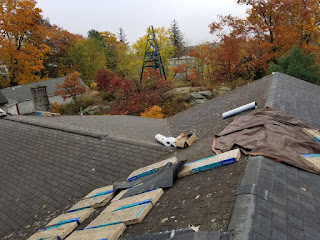Ways to Remove Mold from Your Roof
Mold growth on your roof is not just an
aesthetic issue. It can also pose serious health risks and compromise the
structural integrity of your home. Mold thrives in damp, dark environments, and
your roof can provide the perfect breeding ground if it is not properly
maintained. To ensure the safety and longevity of your roof, it's essential to
address it promptly and effectively.
Here are a few ways to help remove the mold
from your roof.
Identifying Mold on Your Roof
Before learning the removal methods, it's
essential to determine whether your roof has mold. Look for dark patches or
discoloration on your roof's surface. Check carefully in areas prone to
moisture accumulation, such as near chimneys or shaded spots. If you notice a
musty odor inside your home, it could indicate fungal or algae growth on your
roof.
Assessing the Severity of Infestation
Once you've identified the issue, assess the
severity of the infestation. DIY methods can often tackle minor growth, while
extensive mildew coverage may require professional intervention. Consider
factors such as the size of the affected area and whether the rot has
penetrated the roofing material.
Professional Services
Hiring a professional roof cleaning agency is
the safest and most effective option for extensive mold infestations or if
you're uncomfortable tackling the problem yourself. Experienced professionals
have the knowledge, tools, and expertise to thoroughly inspect your roof,
identify the underlying cause, and implement appropriate remediation
strategies.
Techniques Used
Here are some of the techniques professionals
can use to get rid of the infestation.
●
Pressure Washing: It removes mold and mildew
from your roof, especially from larger areas. However, using the appropriate
pressure setting is essential to avoid damaging the roofing material.
Additionally, they exercise caution to prevent water from infiltrating your home's
interior during cleaning.
●
Chemical Treatments: Chlorine bleach diluted
with water kills fungal spores, but it's crucial to take safety precautions and
protect surrounding vegetation from potential harm. The professionals always
wear appropriate protective gear when using chemical treatments.
Preventative Measures
After removing mold from your roof, it's
essential to take preventative measures to inhibit future growth. Make sure
there is proper ventilation in your attic to reduce moisture buildup, trim
overhanging tree branches to allow sunlight to reach your roof, and promptly
address any leaks or damaged roofing materials.
Regular Roof Maintenance
Regular roof maintenance is key to preventing
fungal or algae growth. Schedule annual inspections to check for signs of
damage or deterioration and keep gutters clean and debris-free to prevent water
from pooling on your roof. Mold remediation or structural repairs are
significantly more costly than investing in proper roof construction and maintenance.
Don't let mold and mildew compromise the integrity of your roof and the safety of your home. You can combat fungal growth by identifying it early and using appropriate removal techniques. Roofing experts like Freeman & Son Construction can help you keep your roof in top condition and ensure the safety and comfort of your home. Contact us today to schedule your appointment.




Comments
Post a Comment